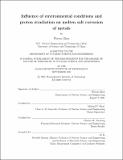Influence of environmental conditions and proton irradiation on molten salt corrosion of metals
Author(s)
Zhou, Weiyue
DownloadThesis PDF (44.57Mb)
Advisor
Short, Michael P.
Terms of use
Metadata
Show full item recordAbstract
Practical applications of molten salts have emerged, especially in the power industry, such as molten salt reactors and concentrated solar power plants. However, the understanding of the molten salts, both physically and chemically, is still lacking. As one of the interactions between molten salts and materials, corrosion is critical to study for the successful deployment of these and other applications.
This thesis contributes to our understanding of corrosion of metals in high temperature molten salts, especially fuorides.
Corrosion of materials in molten salts starts with electrochemical corrosion reactions. However, the evolution of the interface is determined jointly by the corrosion reactions, interdifusion in solids, and surface difusion at the interface. These processes make possible the initiation and growth of tunnels flled with salt. It is recognized here that molten salt corrosion is highly penetrating corrosion in most cases, more penetrating than has ever been recognized. A categorization of molten salt corrosion based on morphology is provided, suggesting the necessity to understand each category and develop new quantifcation methods.
As one mode of penetrating corrosion, intergranular penetrating corrosion in the molten salt is studied further in this thesis. The unique morphology and mechanism call for a new concept of intergranular corrosion as “1D wormhole corrosion”. Asymmetry of the elemental distribution across grain boundaries and the difusion-induced grain boundary migrations are observed.
For applications involving simultaneous radiation, the infuence of radiation on corrosion is critical to understand. A dedicated experimental facility is constructed to study the synergy efect of radiation and corrosion using protons as the irradiation source. Various interaction modes are discovered, including the deceleration of intergranular penetrating corrosion and the acceleration of transgranular penetrating corrosion. Protons are also recognized to push the transition between intergranular and transgranular modes to favor the transgranular one while rendering the salt more corrosive. The complexity of the synergy calls for future studies to understand it, especially for application-relevant cases.
The Discovery of this thesis provides a variety of directions for future studies to follow. It is important that we appreciate the complexity of molten salt corrosion and develop systematic approaches to study it.
Date issued
2021-09Department
Massachusetts Institute of Technology. Department of Nuclear Science and EngineeringPublisher
Massachusetts Institute of Technology